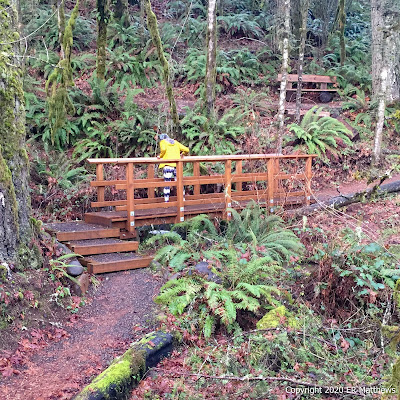Ann and I are walking a lot these days, but there are only so many routes through our side of town and they are getting boring. Although we yearn for the days of weekly far afield and mountainous hikes, neither of us feel comfortable in leaving our old Chuck dog for that long. So we make do walking the neighborhoods near to home. For a change of pace, on New Year's Eve, Ann suggested that we head just three miles west of town into the hills to Miller Woods, a local park with a 4.5-mile loop trail.
It felt wonderful to get out and walk during a temporary break between rain showers. Although the track was extremely muddy in places, it felt good to walk on uneven ground and go up and down hills, something we do not have on the sidewalks around home.
 |
| Oregon White Oak |
 |
| Moss and Lichens on a Big Leaf Maple |
 |
| Black Tail Doe |
One of the big draws for me at Miller Woods is the wide variety of ecosystems in such a compact area. We had traversed a pasture and then an oak savannah before entering a planted section of Douglas fir. As we worked our way down a hill towards a bridge across a stream, I started seeing very fresh deer tracks in the sloppy mud, so fresh that they had not yet filled in with water. The tracks were heading down the trail the same direction as we were and as I lifted my head from examining the tracks, I could see a doe in the trail about fifteen yards ahead of us.
We followed her slowly for perhaps 150 yards. She would stop and check us out every few yards. Finally, she turned off down the hill into the sword ferns on a fairly distinct game trail. She never did spook. Looking up the hillside following along the game trail, we spied yet another doe browsing in the ferns under the firs. We have plenty of deer near the house too and we see them frequently on our walks, but seeing them out in the woods always seems special to us.
 |
| Douglas' Squirrel |
As we moved down the trail from the doe, moving through a low section of old growth forest of ancient Doug firs and western red cedar, a male Pileated Woodpecker called from about thirty feet up the side of a fir. We spotted the noisy bird fairly quickly before it glided off towards the creek looking like a miniature pterodactyl. Pileateds prefer old growth for dead snags and older trees in which they can excavate their nest holes, so we don't see them in town much, unlike back in Winchester where they were a common site among the mature sycamores in town and along the Shenandoah River. I believe that this is the first Pileated that I have seen in Oregon.
Just as the woodpecker flew away, a pair of tiny squirrels came racing sixty or seventy feet down a large fir and then proceeded to chase each other through the underbrush and up another tree. I thought they were Red Squirrels, the common tiny squirrel of eastern coniferous forests. When I went to look up the Red Squirrel range map later in the day, I found that they come into Oregon only in the far northeast corner of the state over by Idaho. Our tiny squirrel of coniferous forests is the Douglas Squirrel.
It's quite amusing to me after having looked up the Red Squirrel range map to see that it doesn't live here to have looked up the Winter Wren to see that it too does not live here. At some point recently (2010, in fact), the Winter Wren was split into three species, our Pacific Wren, the Winter Wren back east, and the European Wren that I have seen in England and Ireland. By whatever name, they are noisy tiny scurriers of the underbrush that you could easily think were mice.
 |
| Dead Fir Draped in Moss |
 |
| Red-Breasted Nuthatch |
There is a lot of bird life at Miller Woods and once in the woods proper we were serenaded not only by the ever-present and ubiquitous Pacific Wrens, but also mixed flocks of winter birds: both kinglets, chickadees, creepers, and nuthatches. We were walking from an old growth area to a more open transition zone when we came across a little blue-gray bundle of fluff right in the middle of the trail.
Naturally, we went immediately to see if the bird were dead or alive and we could see from a couple of feet away that it was breathing, but it let us approach to within inches, as if it were stunned. But within a few seconds, it flew off down the trail ten feet, landed for a moment, and then flew up onto the trunk of a small western hemlock and looked down at us from its upside down perch.
It's really nice to have this delightful park so close to the house. And in winter, it is not very crowded and a good place to get out from being holed up in the house since April.














No comments:
Post a Comment